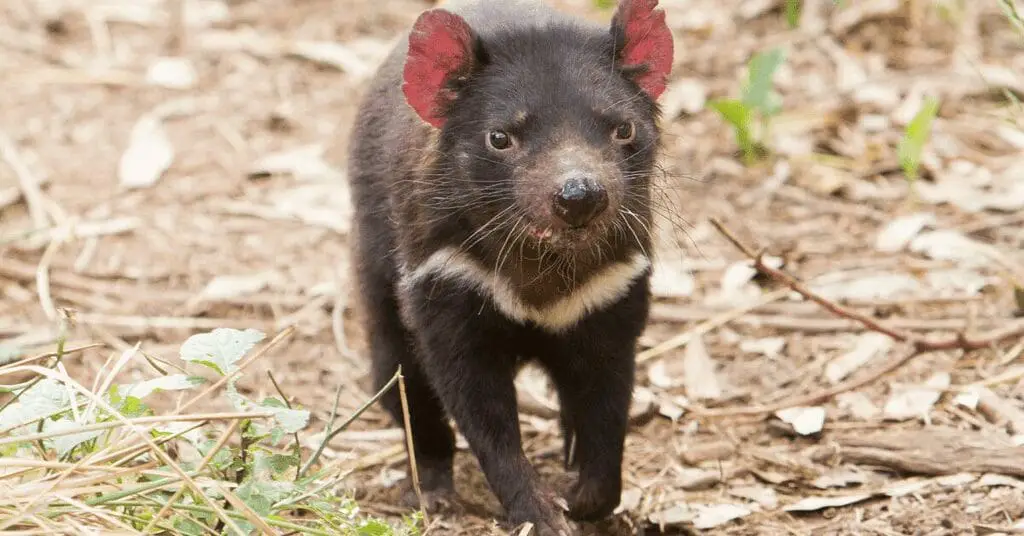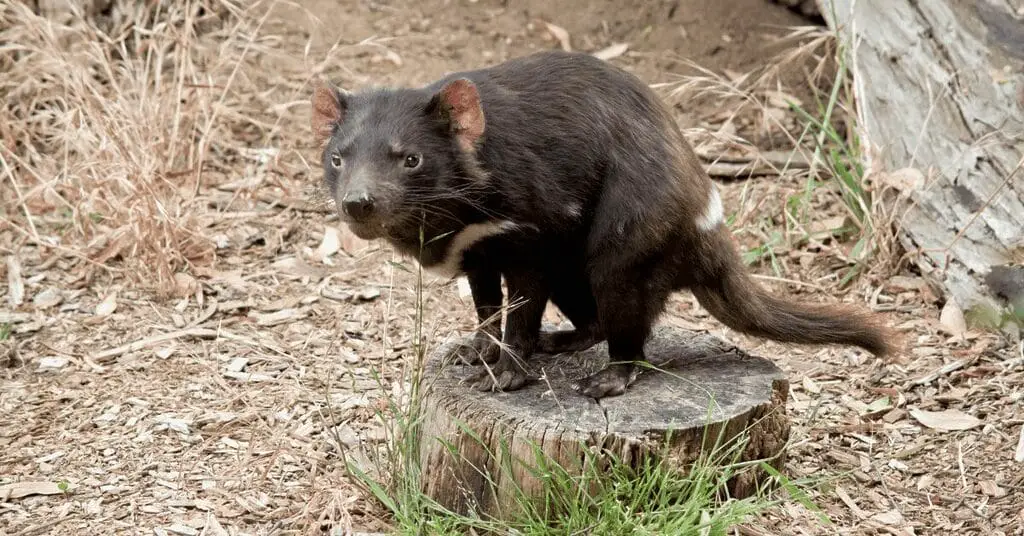Tasmania is home to a myriad of species, each playing a vital role in the ecological tapestry of the region. Among these, the Tasmanian Devil stands out as a symbol of both the fragility and resilience of nature.
Did you know? The Tasmanian Devil, famous for its ferocious demeanor, faces a critical challenge for survival due to a contagious facial tumor disease. This alarming fact underscores the urgent need for awareness and conservation efforts.
This post will share comprehensive and engaging information about Tasmanian Devils. From their intriguing behaviors to the pressing threats they face, we promise to provide insights and answers.

Understanding the Tasmanian Devil: Behavior and Characteristics
The Tasmanian Devil, a unique marsupial native to Tasmania, is often shrouded in mystery and misconceptions. One common question is: “Are Tasmanian Devils dangerous?” The answer is complex.
While they can exhibit aggressive behavior, especially when threatened or feeding, Tasmanian Devils are generally not dangerous to humans. Their fierce reputation largely stems from their loud growls and powerful jaws, which are primarily used for feeding and social interactions within their species.
Tasmanian Devils are solitary animals, but they do come together in communal feeding situations, which can give the impression of them living in groups.
These gatherings are more about opportunistic feeding rather than social living. Unique features of the Tasmanian Devil include their black fur, often with white markings, and their robust build.
A notable and curious phenomenon is the reddening of their ears, which occurs when they are agitated or stressed, indicating increased blood flow to the ears.
Conservation Challenges: Threats and Conservation Efforts
Continuing our exploration of the Tasmanian Devil, we encounter significant conservation challenges that this species faces. The primary threat is the Devil Facial Tumor Disease (DFTD), a contagious cancer that has drastically reduced their population.
This disease spreads through biting, a common behavior in their social interactions, especially during feeding and mating.
Another pressing concern is habitat loss due to human activities and environmental changes. As their natural habitat shrinks, Tasmanian Devils struggle to find adequate food and space, leading to further population decline.
Currently, conservationists estimate only a few thousand individuals remain in the wild, a stark contrast to their once abundant numbers.
The extinction of the Tasmanian Devil would have profound ecological consequences. As top scavengers, they play a crucial role in maintaining the health of their ecosystem by controlling the spread of disease and managing the populations of other species.
Efforts to conserve and protect these animals are ongoing. Initiatives include breeding programs, research into DFTD, and habitat preservation strategies. These endeavors aim not only to save the Tasmanian Devil from extinction but also to preserve the ecological balance of their native environment.
To gain a deeper understanding of these challenges and the efforts in place to overcome them, please refer to our linked articles, which provide detailed insights into the current state of Tasmanian Devil conservation.
Lifestyle and Habits: Daily Life and Diet

Delving deeper into the world of Tasmanian Devils, we uncover fascinating aspects of their daily life and feeding habits. These nocturnal creatures are primarily scavengers, known for their robust appetite and ability to consume a wide range of food.
A Tasmanian Devil’s diet typically includes carrion, insects, birds, and small mammals. Their powerful jaws allow them to consume almost all parts of their prey, including bones and fur, making them efficient cleaners of their ecosystem.
An interesting behavior observed in Tasmanian Devils is their seemingly playful action of running in circles. This behavior is often part of their social interactions or a way to familiarize themselves with their environment.
In terms of speed, while not the fastest marsupials, they can reach considerable speeds when necessary, especially during hunting or escaping predators.
Understanding these aspects of their lifestyle and habits is crucial in appreciating their role in the ecosystem and the unique adaptations they have developed to survive in the wild.
Human Interaction: Domestication and Interaction
Transitioning to the topic of human interaction with Tasmanian Devils, it’s important to address common questions regarding their potential for domestication and natural predators. Contrary to what some may think, Tasmanian Devils are not suitable as pets.
Their wild nature, specific environmental needs, and the risk posed by Devil Facial Tumor Disease (DFTD) make domestication impractical and potentially harmful. Moreover, their conservation status necessitates a focus on protecting them in their natural habitat rather than in domestic settings.
In the wild, adult Tasmanian Devils have few natural predators, thanks to their position as top scavengers. However, young devils are more vulnerable and may fall prey to birds of prey, foxes, or large predatory mammals. Human activities also pose significant risks, including habitat destruction and vehicle collisions.
Understanding the dynamics of human interaction with Tasmanian Devils helps in formulating effective conservation strategies and in fostering a respectful coexistence.
For more detailed information on the relationship between humans and Tasmanian Devils, and why they are unsuitable as pets, refer to our linked articles which provide in-depth exploration of these topics.
History and Mystery: Origin and Legends

Venturing into the historical and mythical realms, the Tasmanian Devil’s story is as captivating as its presence. The origin of their name, “Tasmanian Devil,” is steeped in the early settlers’ experiences, who were intrigued and perhaps intimidated by their loud and fierce nocturnal noises, leading to the devilish association. This name has since become a symbol of Tasmania’s unique wildlife.
In addition to Tasmanian Devils, the island’s lore is also home to the enigmatic Thylacine, commonly known as the Tasmanian Tiger.
Once thought to be extinct since the 1960s, the Thylacine continues to capture the imagination, with ongoing debates and investigations into its possible continued existence. This mystery reflects the complexity and the unknowns still present in our understanding of Tasmania’s wildlife.
Furthermore, the intriguing idea of resurrecting the extinct Thylacine through scientific advancements has sparked both excitement and ethical debates. Such endeavors highlight the intersection of science, conservation, and the ethical considerations of interfering with nature.
This section of our hub delves into these captivating stories, providing insights into the history, myths, and ongoing mysteries surrounding these iconic Tasmanian species.
For a deeper dive into the origin of the Tasmanian Devil’s name, the elusive Thylacine, and the scientific endeavors surrounding it, explore our linked articles. These pieces offer a comprehensive view of the rich tapestry of Tasmania’s wildlife history and the mysteries yet to be unraveled.
Conclusion
The Tasmanian Devil, a unique and vital part of Tasmania’s ecosystem, presents a world filled with intriguing behaviors, significant conservation challenges, and unique interactions with humans.
These creatures, known for their distinct characteristics and misunderstood nature, face grave threats from disease and habitat loss. Their dietary habits and social behaviors, although often misunderstood, play a crucial role in the natural balance of their environment.
The relationship between humans and Tasmanian Devils is complex, marked by conservation efforts and the understanding of their unsuitability for domestication.
Additionally, the rich history and legends surrounding these animals, including the mysterious Thylacine, add a layer of intrigue and highlight the importance of ongoing research and conservation.
This exploration into the fascinating world of the Tasmanian Devil underscores the need for continued awareness and action to protect these remarkable creatures and their habitat, ensuring their survival for generations to come.

